Barberry care and growing guide: how to look after berberis shrubs in your backyard
These expert tips will help your barberry bush flourish
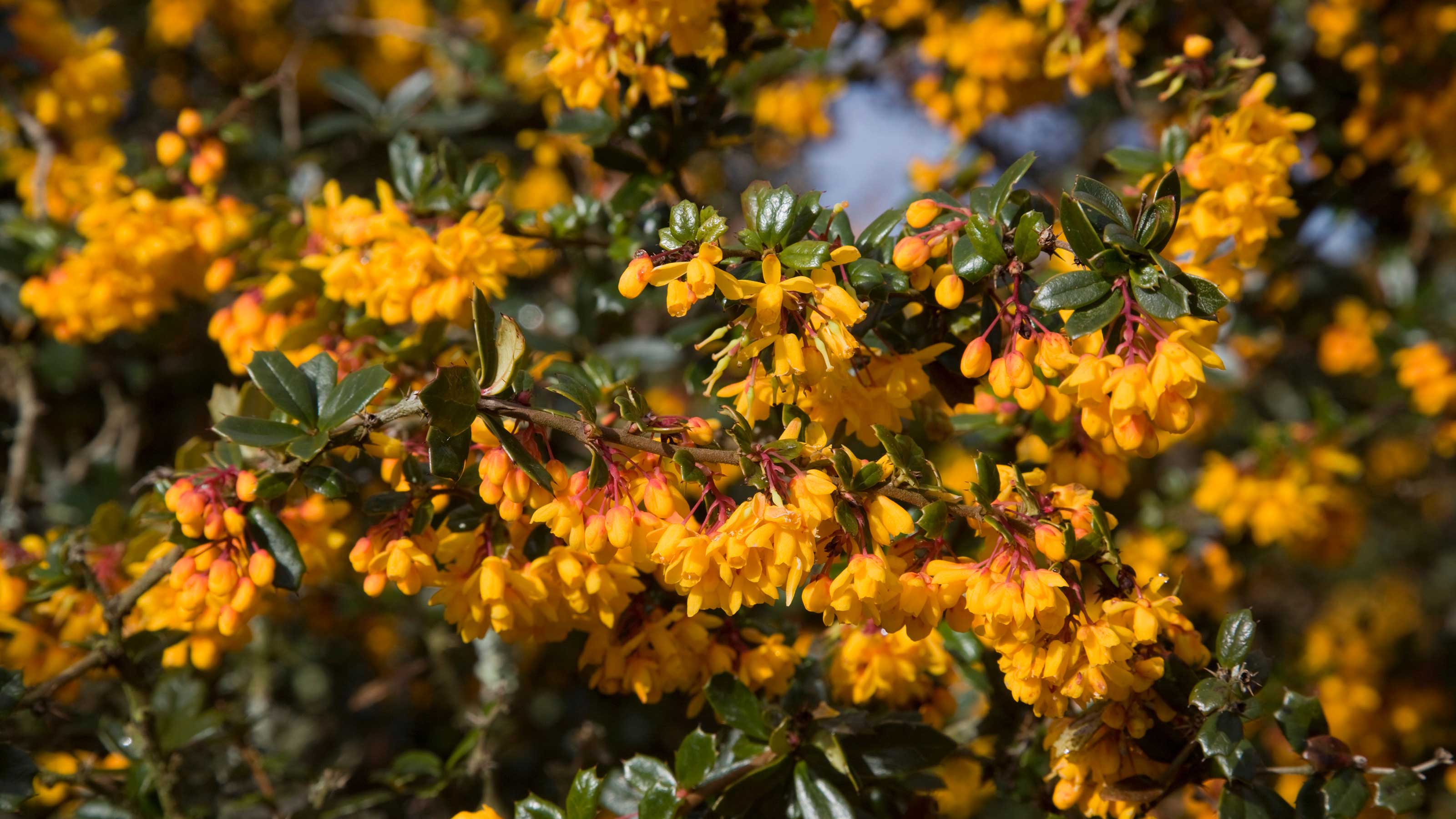

Barberry shrubs, otherwise known as berberis, are easy-to-grow, small or medium-sized, and thorny. They can be deciduous or evergreen and grow naturally across northern Europe, northern Asia and also South America.
The foliage of these low-maintenance shrubs is usually small and rounded or oval in shape, and the leaves of deciduous varieties often change to fiery fall colors. Short, sharp spines develop at the leaf joints, often in threes. The wood of barberry branches and twigs is a distinctive yellow color.
The small flowers, usually yellow or orange, appear in clusters in spring which can create a colorful display. In many varieties, they are followed by small, egg-shaped berries that tend to be dark blue, black or red. Even an isolated plant will often produce a prolific crop of them.
'As ornamental shrubs, the barberries have many good qualities and several of them are in the very first rank of garden plants. They prefer warm, loamy soil, but are by no means fastidious,' says the international experts at Trees and Shrubs Online.
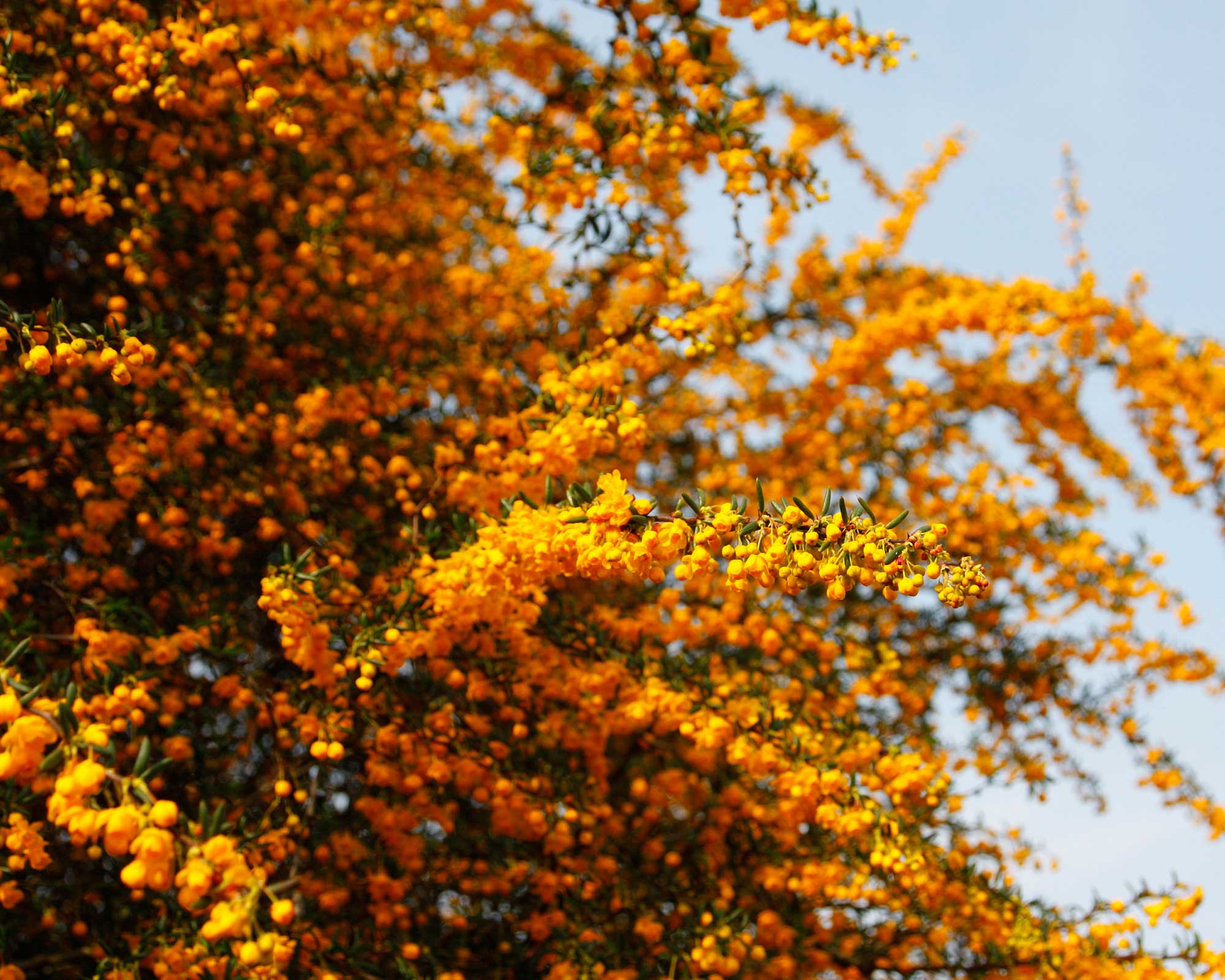
Berberis x stenophylla
Barberry key facts:
- Plant type: Deciduous and evergreen shrubs
- Mature size: 2-10ft (60cm-3m)
- Soil type: Any that is not parched or swampy
- Soil pH: Any
- Time of year to plant: Spring, fall
- Flowering time of year: Spring
- Flower color: Yellow, gold, orange
- Hardiness zones: USDA 4-7 (UK H5-7)
- Scientific name: Berberis
- Common name: Barberry
What are the two main types of barberry?
Deciduous barberry plants make twiggy and very thorny shrubs that are grown for their colorful spring flowers, often carried on bare branches; for their red berries; and for their colored or variegated foliage which often develops red or yellow fall color.
Most of the deciduous barberries grown are varieties of Berberis thunbergii (Japanese barberry). These are one of the most adaptable and cold-hardy of all deciduous shrubs. The flowers are yellow and tinted in red. The berries are bright red and the foliage may be green, reddish-purple, or golden yellow and is sometimes speckled or edged in yellow or white. Fall foliage color is brilliantly fiery.
The evergreen shrub varieties tend to be dense, well-branched, and less hardy. Berberis darwinii is the most widely grown, with thorny leaves and twigs. The bright orange spring flowers open in drooping clusters over a long period before maturing into rounded, plum-colored fruits.
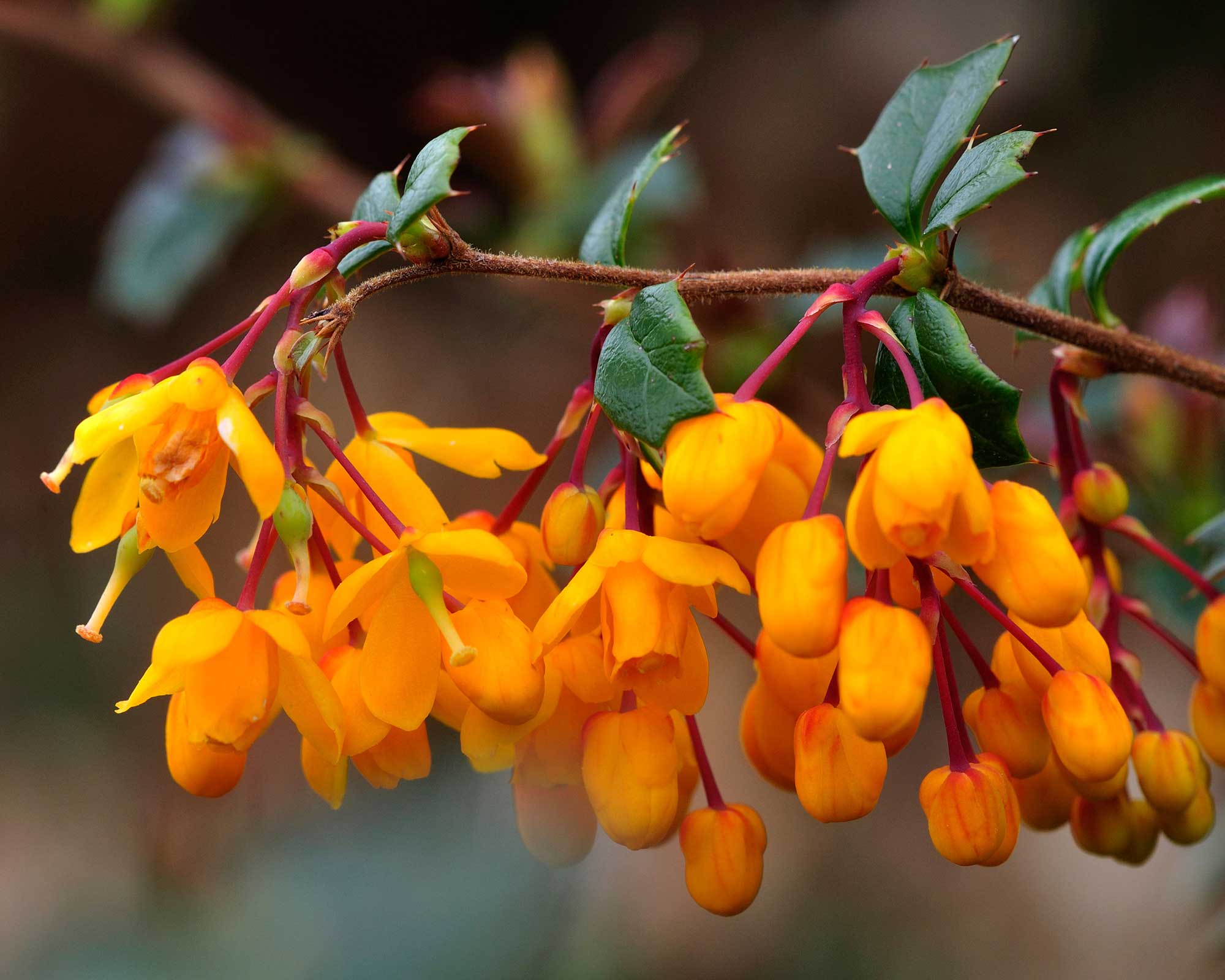
Berberis darwinii
How to plant barberry shrubs
'Berberis are generally of easy cultivation, thriving in sun or shade and in almost any soil that is not waterlogged,' says The Royal Horticultural Society.
Barberries are unusual in thriving in full sun and also in the shade of deciduous trees, although they develop better leaf color in at least some sunshine. Beware, though, that yellow-leaved varieties may scorch in full sun, especially in dry periods.
Any soil that is not permanently wet suits barberries. They grow well in soils that are not strongly fertile, but in poor conditions, they may not branch well and develop a thin look.
No special planting technique is needed, though beware of the thorns when handling the plants – gardening gloves are a must (Amazon has a wide range). Spring and fall are the best times to plant them.
They are well-suited to mixed borders, in flower beds, as edging plants, or as foundation planting. Taller varieties make good multi-season specimens. Due to the thorns, keep them away from your garden paths.
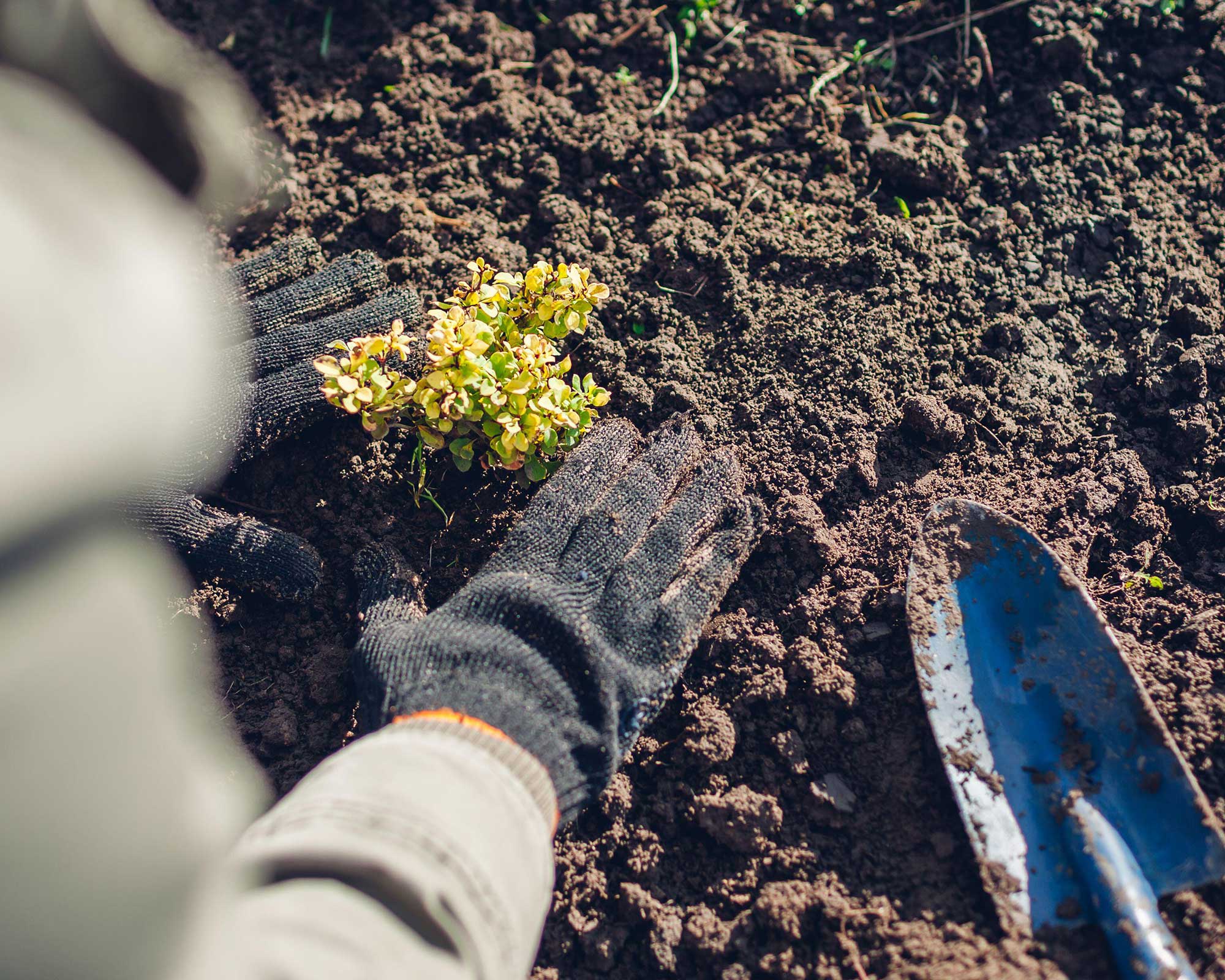
Beware of thorns when planting berberis
How to care for barberries
In general, barberries need little special care.
If larger types get out of hand, they can be pruned back in spring after flowering. Pruning the shrubs at this time of year will also encourage a good floral display the following year. The problem is that pruning after flowering can remove all the growth that carries the colorful berries.
The solution, then, is to prune after flowering, but not by clipping over the whole plant. Instead, select two or three of the longest branches and prune them back by about half, cutting just above a healthy side branch. Pruning in this way will prompt new growth from lower down on the plant, but without sacrificing the fall fruiting display.
Occasional trimming may also be needed to maintain the shape of smaller varieties that grow in pillars or balls, but they usually keep their shape well unless damaged. If your barberry bush needs dramatic renovation, cut it back to 12in (30cm) in late winter.
Other than that, mulching in fall will prevent weed development and also help keep the roots moist, which will lead to richer growth and more prolific berry production.
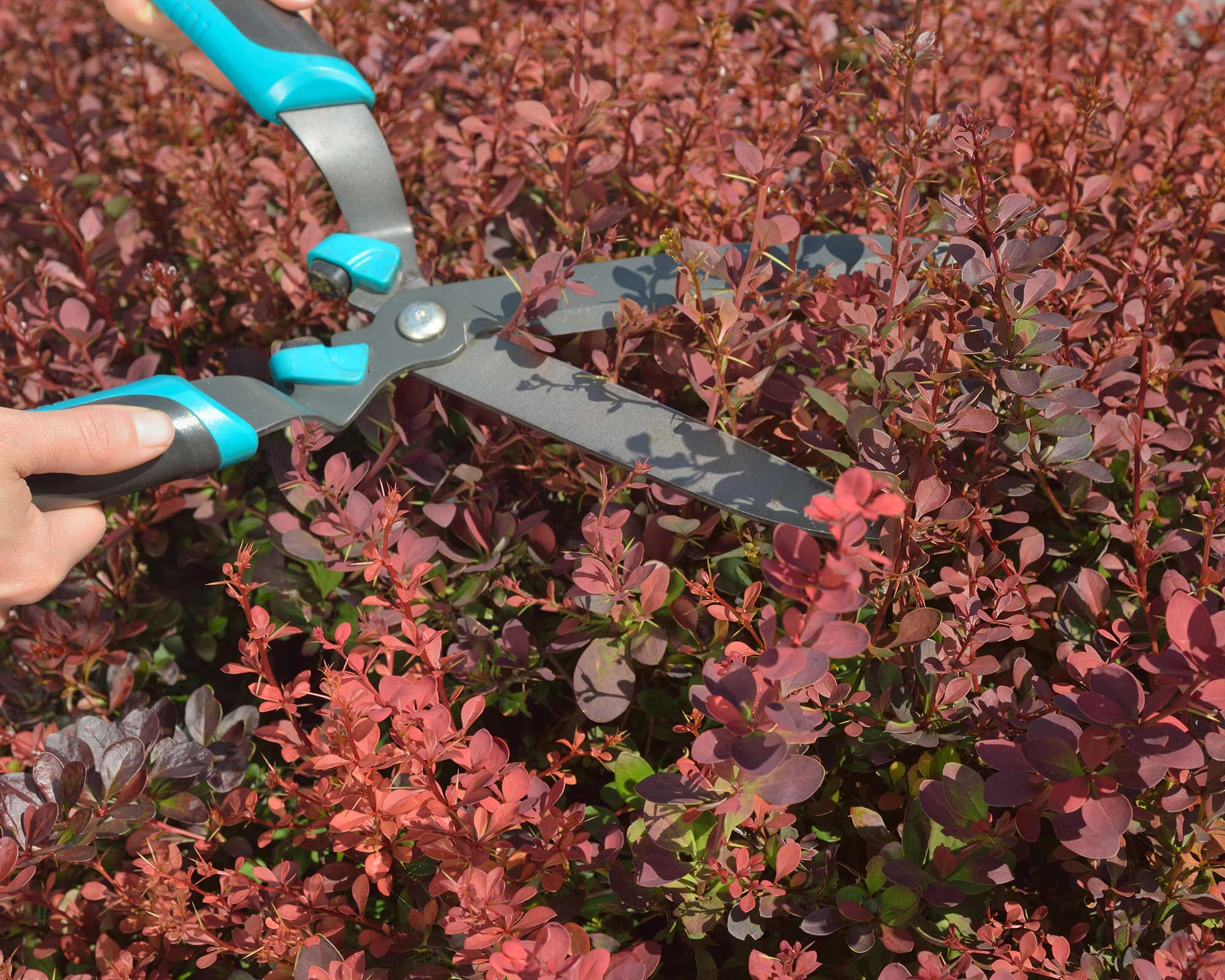
Prune berberis after flowering
How to make more barberry plants
Most barberries are not easy to propagate. They can be rooted from plant cuttings, but the success rate tends to be low. It is, however, possible to bend branches of larger varieties down to the ground and weigh them with a brick or rock to keep the branch in contact with the soil – roots should slowly develop.
Japanese barberry, and some other varieties, sometimes spread a little at the base and, in early spring, it can be possible to detach a piece with twigs and roots and re-plant it elsewhere. This is the way to go if you only need one or two extra plants.
Barberries can also be raised from seeds. You may well find seedlings of Japanese barberry coming up in your borders as a result of birds eating the berries and then excreting the seeds. This is how barberry becomes invasive in some areas. However, seedlings are rarely the same as the parent.
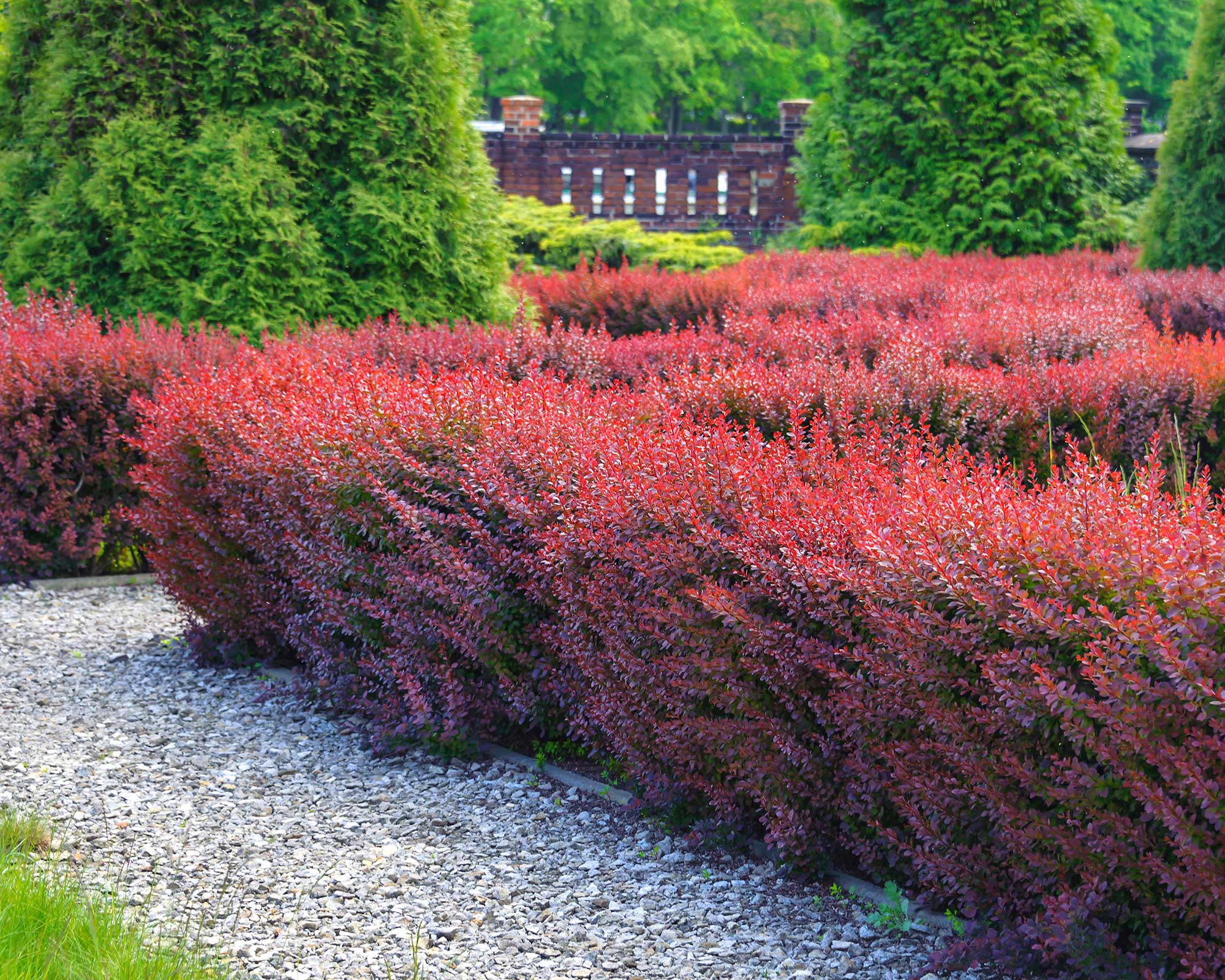
Berberis can be grown as a colorful hedge
Solving common problems with barberries
The main problem with barberry plants – Japanese barberry in particular – is their tendency to spread to parts of the garden (and outside the garden) where they are not wanted. So, do not plant them in areas where they are banned or not recommended.
Powdery mildew is the main disease problem. The dusty white coating on the leaves is usually only seen in hot, dry conditions, so keeping the roots moist is a big help.
Sawfly larvae – white grubs with black and yellow spots – eat barberry foliage and are becoming an increasingly serious problem. They can be picked off by hand or sprayed with an organic pesticide.
There can also be a problem with some golden-leaved varieties due to the shoot tips burning in hot sun. Planting in partial shade is one approach, but there are also some recently-introduced varieties that are burn-resistant. These include 'Sunjoy® Gold Pillar' (‘Maria’) – available at Nature Hills, and 'Sunjoy® Citrus' (‘Koren’), also at Nature Hills.
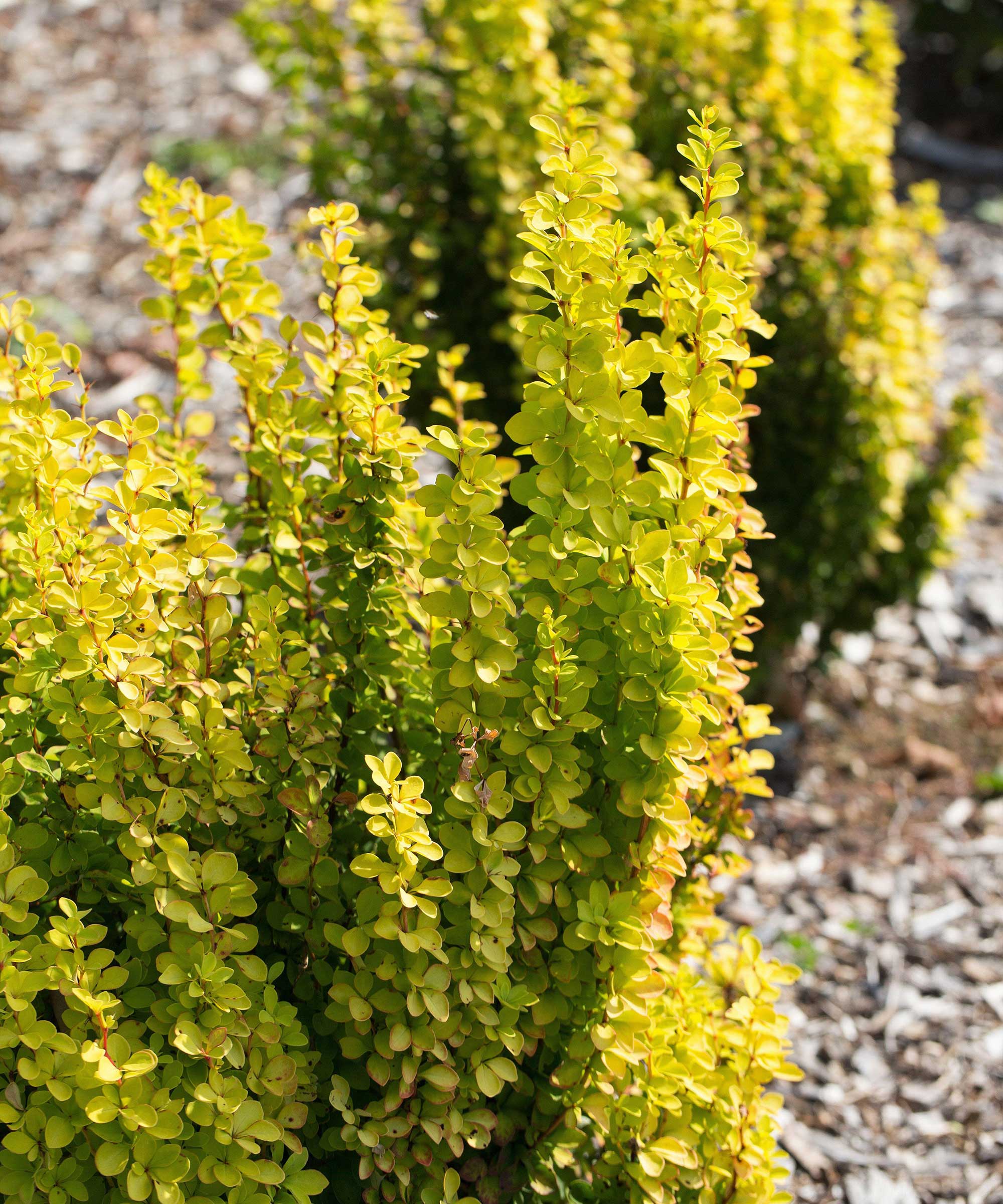
Sunjoy® ‘Gold Pillar’ (‘Maria’) is a recent introduction grown for its upright, neat habit and foliage that is resistant to scorching in hot weather
How to choose barberries for your backyard
Deciduous barberries are among the most reliable and attractive shrubs. As you think about planting them, there are three features to consider: shape, color, and size.
Barberries vary in shape, from almost spherical to conventionally bushy or narrow and upright.
The small, rounded leaves also range in color from dull green through to many rich reddish-purple tones to orange and yellow, plus variegated types.
Then there’s plant size, from very small and neat to big and bushy. ‘Golden Ring’ (purple leaves, edged gold; bushy), ‘Golden Treasure’ (yellow leaves; tight and rounded), ‘Helmond Pillar’ (purple leaves, very upright) and ‘Rose Glow’ (purple leaves, mottled silver; bushy – available at PlantingTree.com) are especially good if you're looking for hedging plants.
Evergreen barberries are less frost tolerant than deciduous varieties. But, where the climate allows, Berberis darwinii makes a colorfully-prolific plant with masses of orange flowers.
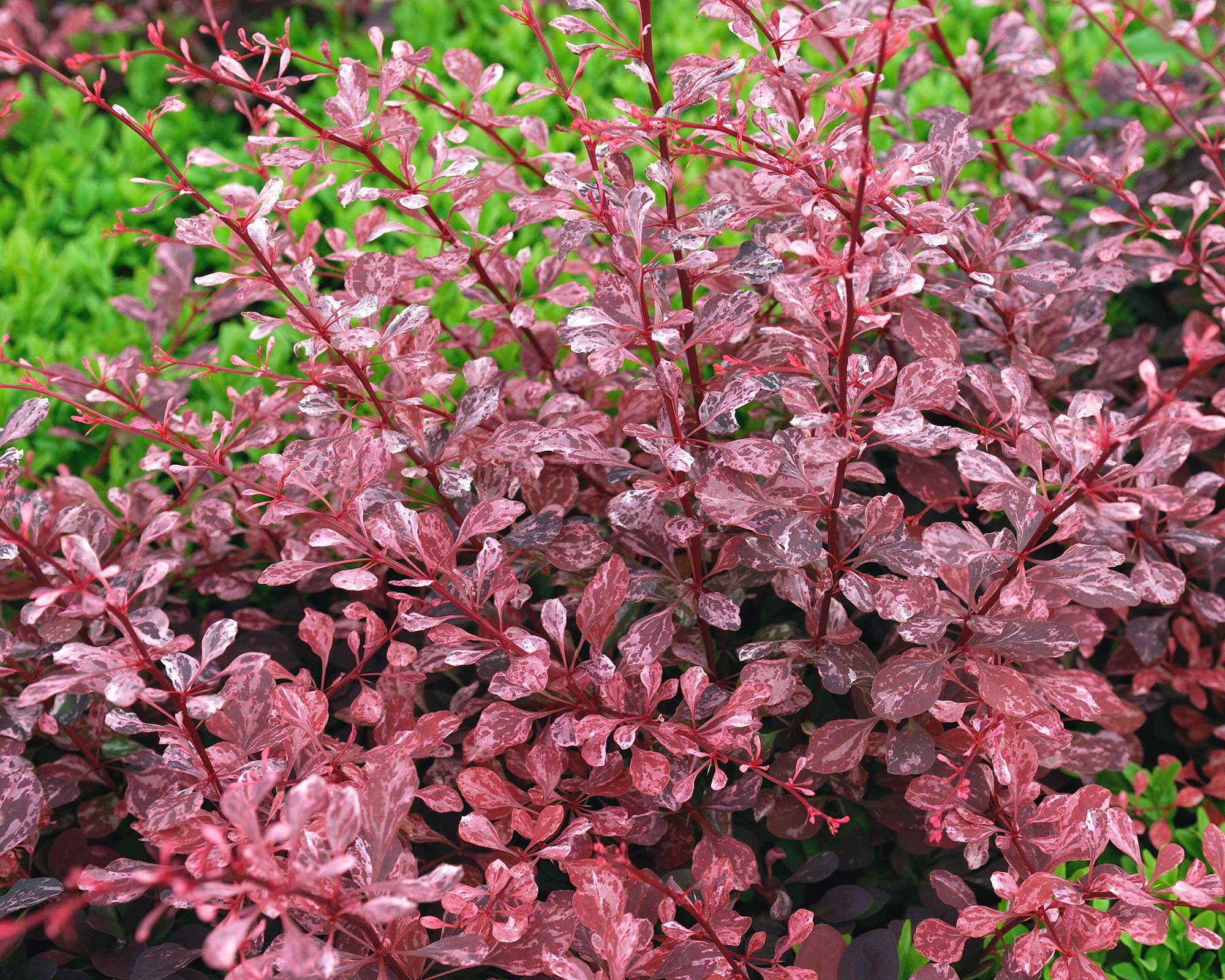
Japanese barberry comes in many shapes, colors and sizes. Berberis thunbergii ‘Harlequin’ provides interest throughout summer with its attractive, mottled pink foliage
Are barberries fast growing?
Some varieties of barberry are fast-growing shrubs, yet some are very slow. The fastest varieties, evergreen or deciduous, reach about 6-8ft (2-2.5m) in ten years.
In evergreens, Berberis darwinii is one of the most vigorous, with tiny holly-like leaves and a dramatic show of red-tinted yellow flowers in spring. Berberis julianae also grows strongly and is one of the tallest: it has bright, glossy leaves but is exceptionally thorny. Even more vigorous, though a little less vicious, is Berberis x stenophylla with very dark, slender leaves and showy, fragrant, yellow spring flowers.
In deciduous barberries, the old-favorite Berberis thunbergii ‘Atropurpurea’ has exceptional vigor, rich purple foliage, yellow spring flowers and red fall berries. But bear in mind that a large plant can produce far too many self-sown seedlings, which then have to be pulled out.
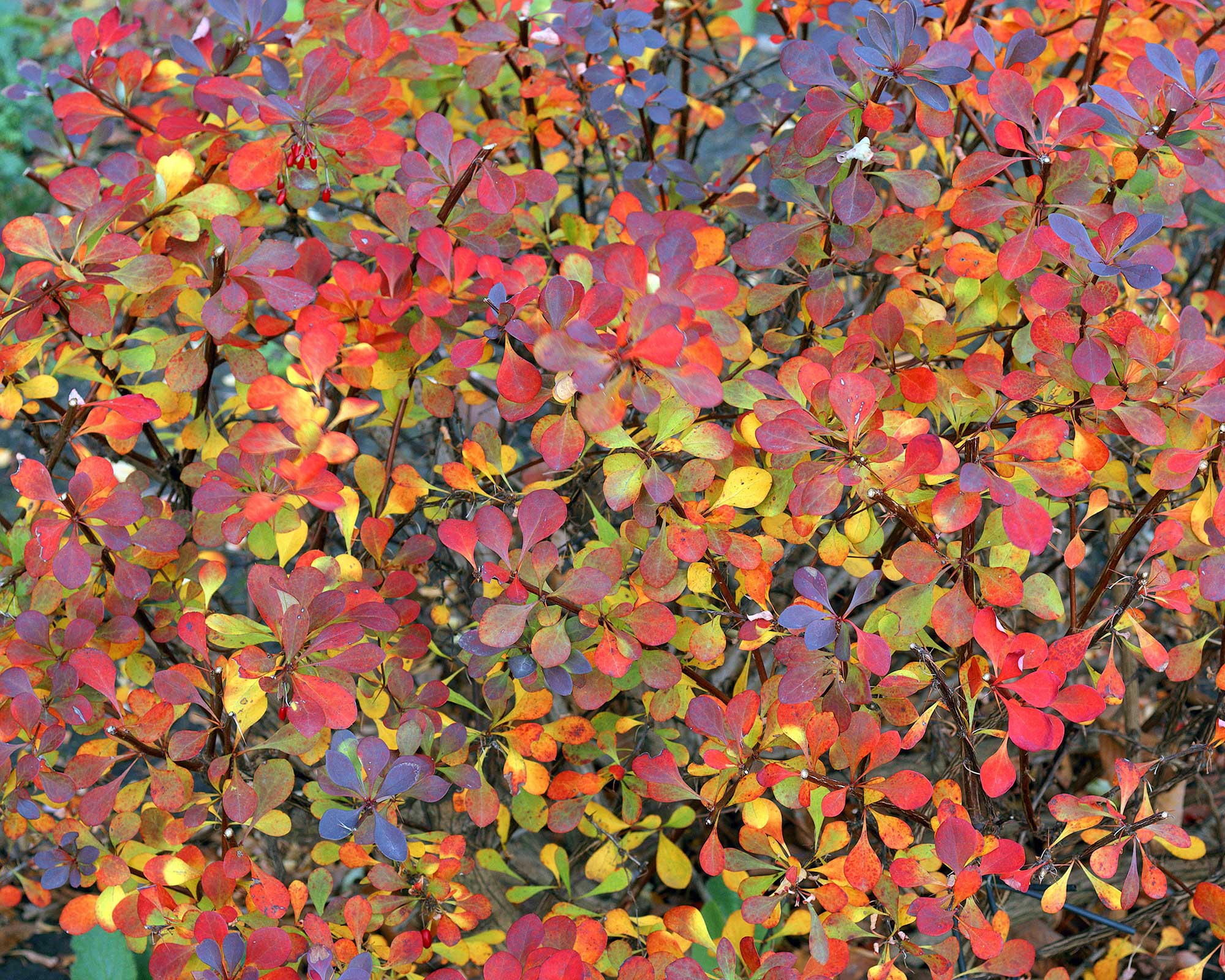
Deciduous B. thunbergii in autumn
What height do barberries grow to?
Barberries vary in their final height at maturity, from plants little more than knee-high that are good for small gardens, to plants way over head-high.
For a genuine dwarf variety that will rarely grow more than about knee-high, try ‘Crimson Pygmy’ (deep red) or ‘Tiny Gold’ (yellow). Maturing a little taller, at about waist height, there is ‘Helmond Pillar’ (purple, upright habit) and ‘Admiration’ (purple, golden edge). At head height, consider ‘Harlequin’ (purple, mottled pink) or ‘Aurea’ (golden yellow).
For really tall varieties, try dark-leaved deciduous ‘Superba’, ‘Atropurpurea’, or the orange-flowered evergreen Berberis darwinii.
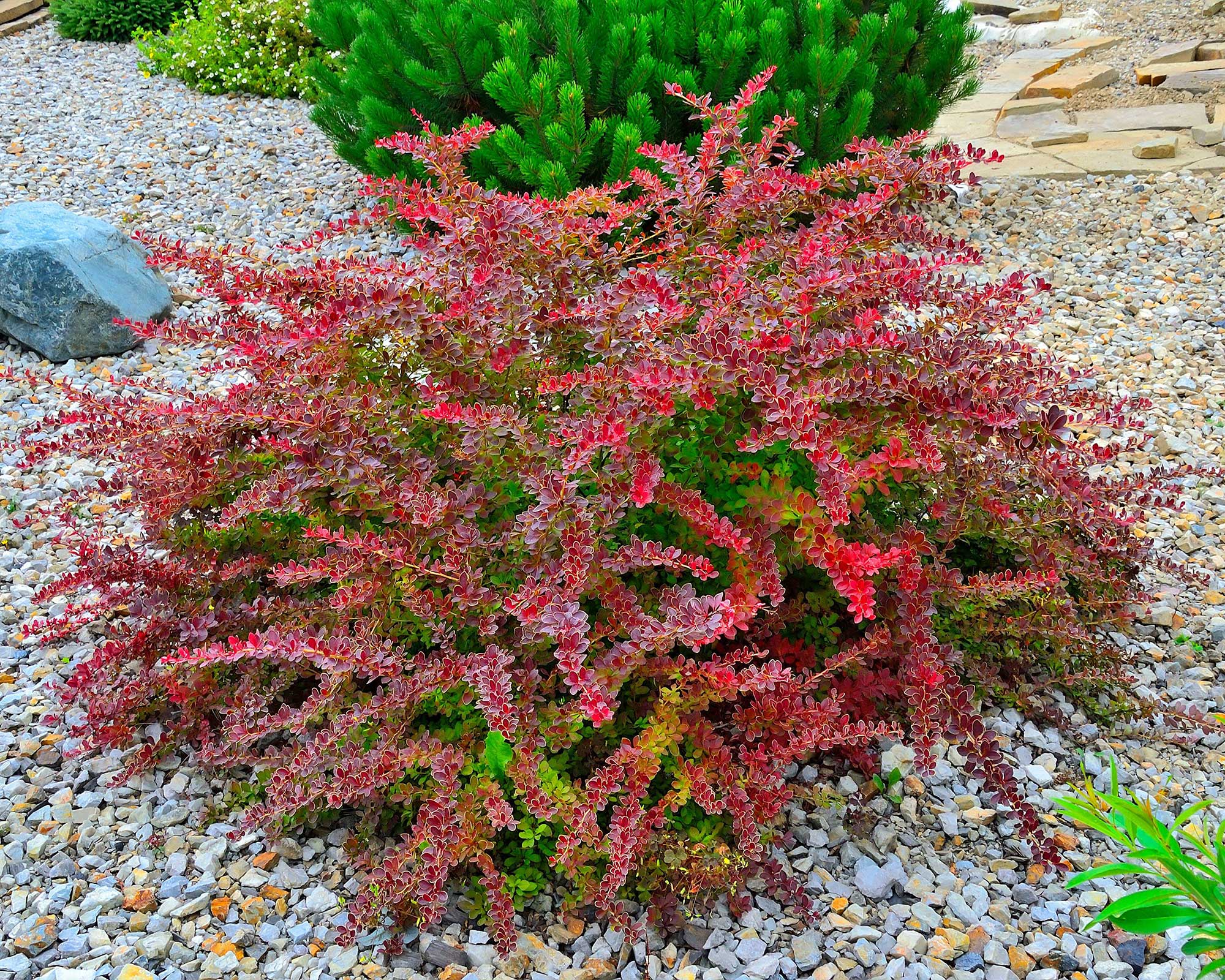
Berberis ‘Golden Ring’ makes a compact, bushy shrub
Are barberries deer resistant?
Yes, berberis are deer-resistant plants. This is one reason that they are invasive in some parts of the country. The deer eat many of the native shrubs, but not barberries, so the barberry has plenty of space into which it can spread.
The New Jersey Agricultural Experiment Station has a program in which they consult a wide range of landscape professionals, horticulturalists, designers and researchers to identify the garden plants that deer prefer to eat – and those that they do not. They rate barberry as 'Rarely damaged', the top rating out of four for deer resistance.
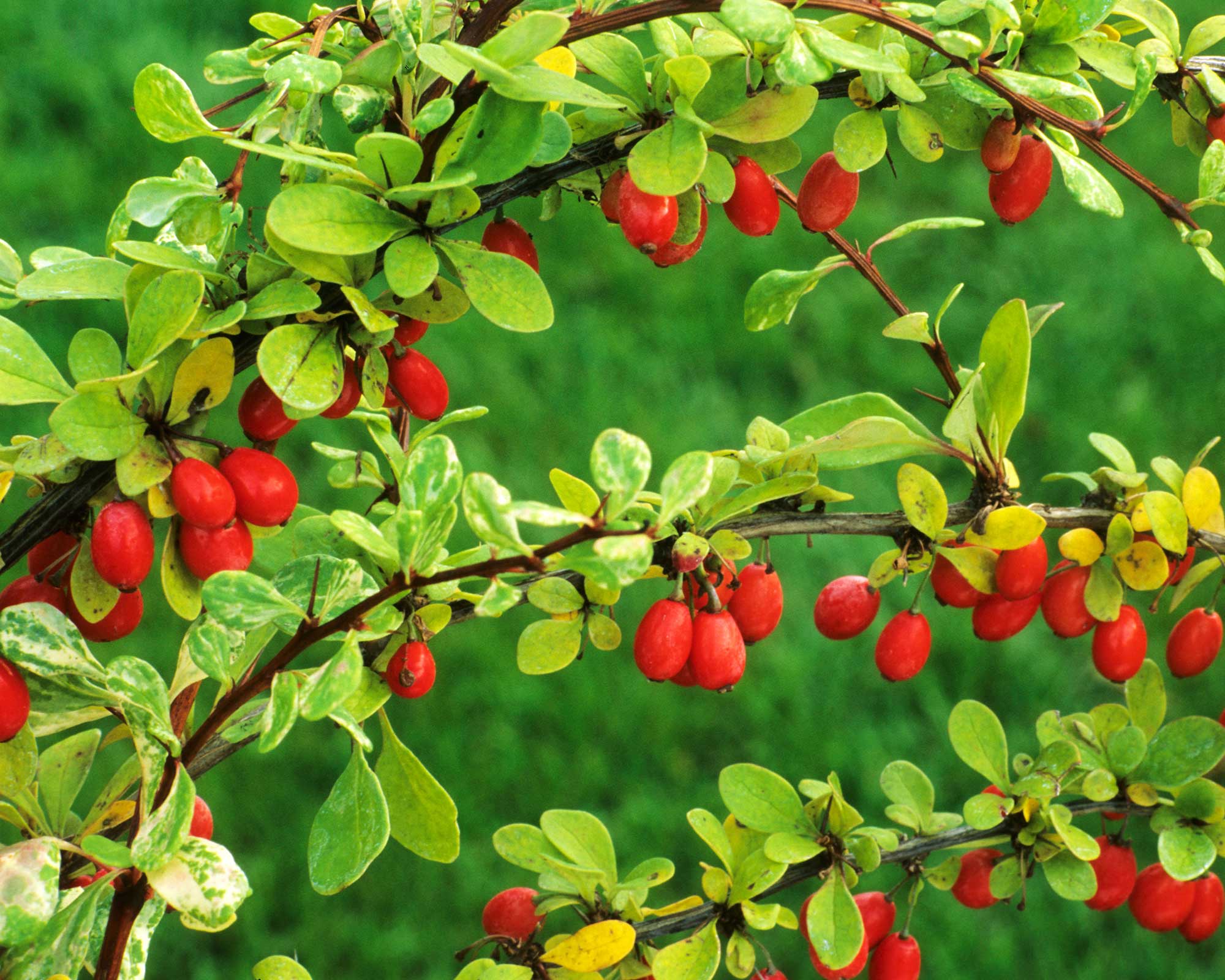
Avoid removing the berries by judicious pruning
Are barberries invasive?
Yes, in some regions, barberry is an invasive plant. The experts at Invasive.org point out: 'Japanese barberry occurs and is reported to be invasive throughout the northeastern U.S from Maine to North Carolina and west to Wisconsin and Missouri.' It can also be a problem in some parts of southern Ontario, Quebec and Nova Scotia.
It grows well in conditions from full sun to deep shade and can form dense thickets which, although generally only reaching around 2-5ft (60cm-1.5m) high, are impenetrable owing to the tangle of dangerously thorny growth. It develops in a wide variety of habitats including forests, open woodlands, fields and scrub.
Recently, however, varieties have been developed that produce no seeds at all, and these are just starting to come onto the market. Look out for the WorryFree® Series.
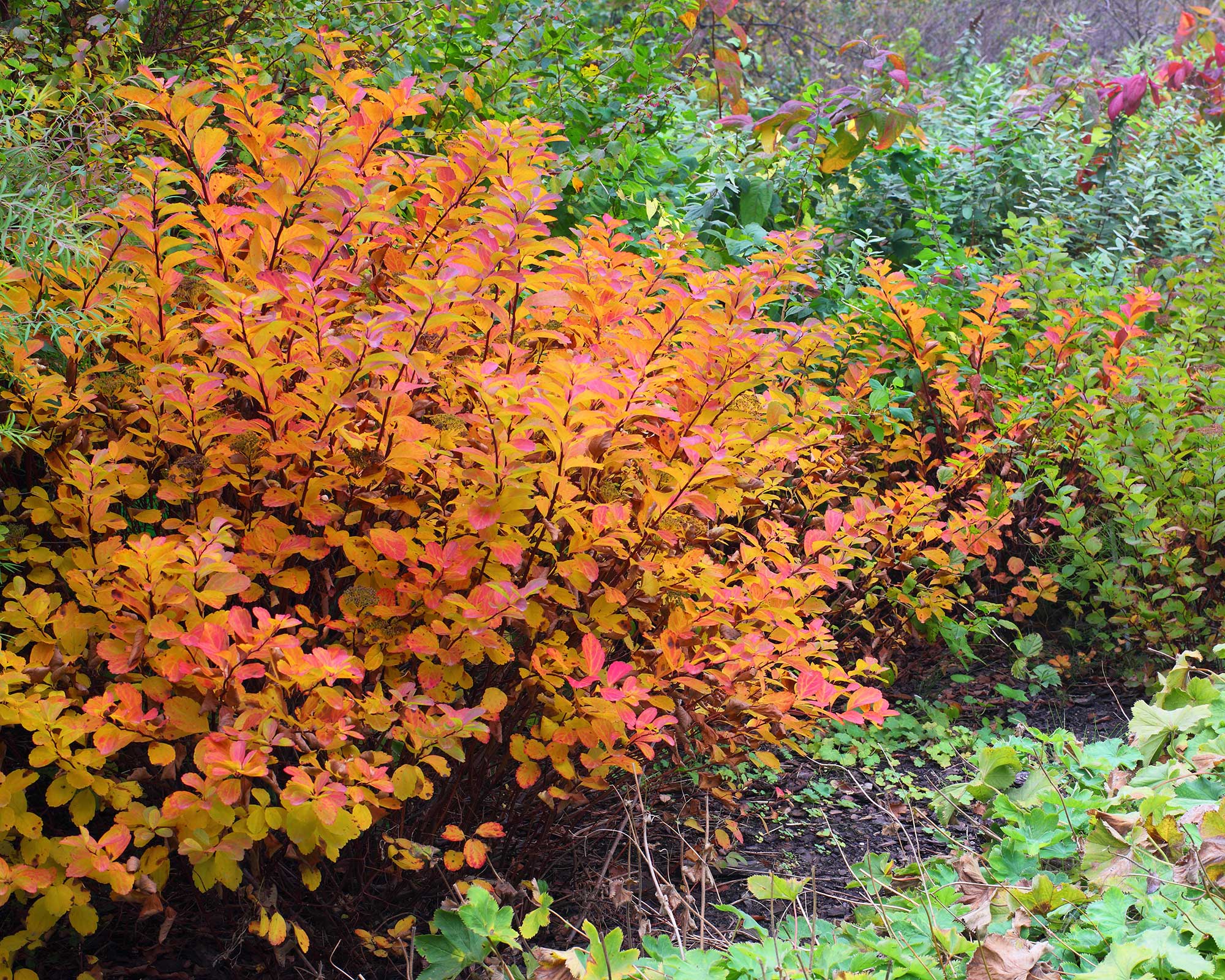
Many barberry bushes bring vibrant color to the fall garden
How to buy barberries
First, find out if barberries are cited as invasive in your area. Your local cooperative extension service and local nurseries can provide advice. Do not consider buying Japanese barberry if it causes problems in your area. Awareness of the problems that barberries cause, in the northeast, in particular, has led to many garden centers and other retail outlets only offering them if they are safe to plant in the area.
Most barberries have attractive foliage that appeals over many months so, in garden centers, they are offered from spring to fall, in gallon pots or larger.
As is usually the case, mail-order suppliers offer a wider range, from small plants in tubes to larger plants in gallons or up to three gallons. Plants in tubes are the most economical option, especially as shipping costs are less.
Where to buy barberry plants
If you'd like to grow a barberry bush in your backyard, our roundup of quicklinks will help start your search.
Where to buy barberry plants in the US
- Buy barberry plants at Nature Hills
- Buy barberry plants at Amazon
- Buy barberry plants at Plants By Mail
- Buy barberry plants at Planting Tree
- Buy barberry plants at Monrovia
- Buy barberry plants at Wilson Brothers
Where to buy barberry plants in the UK

Graham Rice is a garden writer who has won awards for his work online, and in books and magazines, on both sides of the Atlantic. He is a member of a number of Royal Horticultural Society committees and the recipient of the 2021 Garden Media Guild Lifetime Achievement Award.
